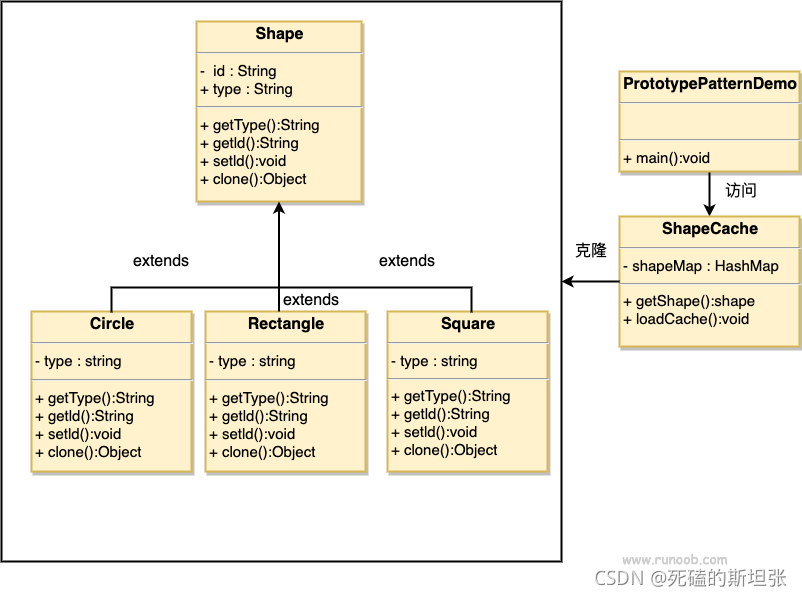意图:用原型实例指定创建对象的种类,并且通过拷贝这些原型创建新的对象。
主要解决:在运行期建立和删除原型。
何时使用: 1、当一个系统应该独立于它的产品创建,构成和表示时。 2、当要实例化的类是在运行时刻指定时,例如,通过动态装载。 3、为了避免创建一个与产品类层次平行的工厂类层次时。 4、当一个类的实例只能有几个不同状态组合中的一种时。建立相应数目的原型并克隆它们可能比每次用合适的状态手工实例化该类更方便一些。
如何解决:利用已有的一个原型对象,快速地生成和原型对象一样的实例。
关键代码:
1、实现克隆操作,在 JAVA 继承 Cloneable,重写 clone(),在 .NET 中可以使用 Object 类的 MemberwiseClone() 方法来实现对象的浅拷贝或通过序列化的方式来实现深拷贝。
2、原型模式同样用于隔离类对象的使用者和具体类型(易变类)之间的耦合关系,它同样要求这些"易变类"拥有稳定的接口。

步骤 1
创建一个实现了 Cloneable 接口的抽象类。
Shape.java
public abstract class Shape implements Cloneable {
private String id;
protected String type;
abstract void draw();
public String getType(){
return type;
}
public String getId() {
return id;
}
public void setId(String id) {
this.id = id;
}
public Object clone() {
Object clone = null;
try {
clone = super.clone();
} catch (CloneNotSupportedException e) {
e.printStackTrace();
}
return clone;
}
}
步骤 2
创建扩展了上面抽象类的实体类。
Rectangle.java
public class Rectangle extends Shape {
public Rectangle(){
type = "Rectangle";
}
@Override
public void draw() {
System.out.println("Inside Rectangle::draw() method.");
}
}
Square.java
public class Square extends Shape {
public Square(){
type = "Square";
}
@Override
public void draw() {
System.out.println("Inside Square::draw() method.");
}
}
Circle.java
public class Circle extends Shape {
public Circle(){
type = "Circle";
}
@Override
public void draw() {
System.out.println("Inside Circle::draw() method.");
}
}
步骤 3
创建一个类,从数据库获取实体类,并把它们存储在一个 Hashtable 中。
ShapeCache.java
import java.util.Hashtable;
public class ShapeCache {
private static Hashtable<String, Shape> shapeMap
= new Hashtable<String, Shape>();
public static Shape getShape(String shapeId) {
Shape cachedShape = shapeMap.get(shapeId);
return (Shape) cachedShape.clone();
}
// 对每种形状都运行数据库查询,并创建该形状
// shapeMap.put(shapeKey, shape);
// 例如,我们要添加三种形状
public static void loadCache() {
Circle circle = new Circle();
circle.setId("1");
shapeMap.put(circle.getId(),circle);
Square square = new Square();
square.setId("2");
shapeMap.put(square.getId(),square);
Rectangle rectangle = new Rectangle();
rectangle.setId("3");
shapeMap.put(rectangle.getId(),rectangle);
}
}
步骤 4
PrototypePatternDemo 使用 ShapeCache 类来获取存储在 Hashtable 中的形状的克隆。
PrototypePatternDemo.java
public class PrototypePatternDemo {
public static void main(String[] args) {
ShapeCache.loadCache();
Shape clonedShape = (Shape) ShapeCache.getShape("1");
System.out.println("Shape : " + clonedShape.getType());
Shape clonedShape2 = (Shape) ShapeCache.getShape("2");
System.out.println("Shape : " + clonedShape2.getType());
Shape clonedShape3 = (Shape) ShapeCache.getShape("3");
System.out.println("Shape : " + clonedShape3.getType());
}
}
总结
关键是要分清浅拷贝和深拷贝的使用场景和具体使用,原型模式本质就是针对具有同质化内容的单一clone,达到节省计算开销和代码量的方式。
 原型模式:克隆对象与易变类解耦
原型模式:克隆对象与易变类解耦





 本文介绍了原型模式的原理,如何通过实现Cloneable接口和克隆方法创建对象实例,以及其在系统独立性、动态加载和减少类层次结构方面的应用。通过Shape、Rectangle、Square和Circle类实例演示,以及ShapeCache类缓存和ShapeDemo的使用实例,展示了如何利用原型模式进行对象复制和解耦。
本文介绍了原型模式的原理,如何通过实现Cloneable接口和克隆方法创建对象实例,以及其在系统独立性、动态加载和减少类层次结构方面的应用。通过Shape、Rectangle、Square和Circle类实例演示,以及ShapeCache类缓存和ShapeDemo的使用实例,展示了如何利用原型模式进行对象复制和解耦。
















 1889
1889

 被折叠的 条评论
为什么被折叠?
被折叠的 条评论
为什么被折叠?








